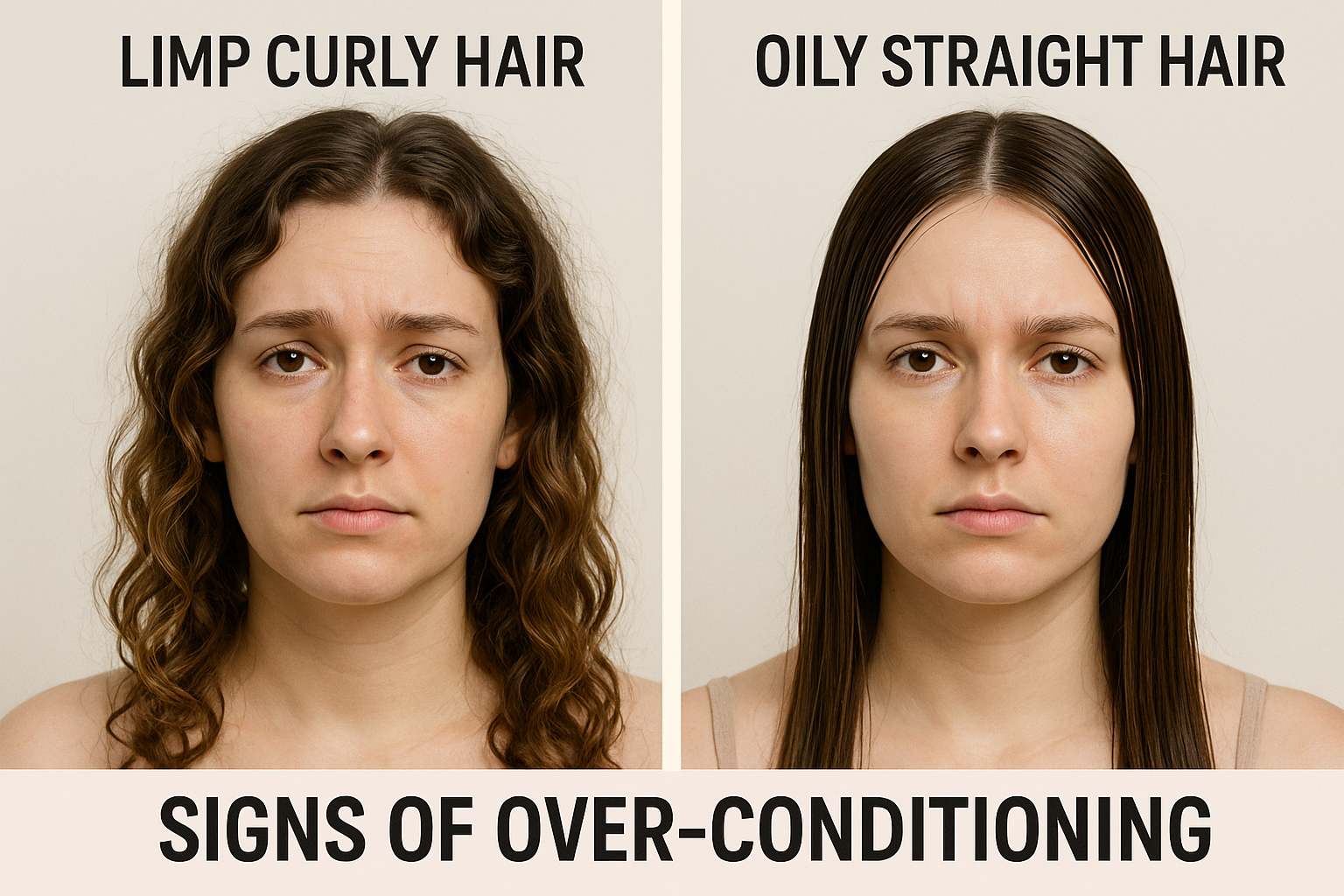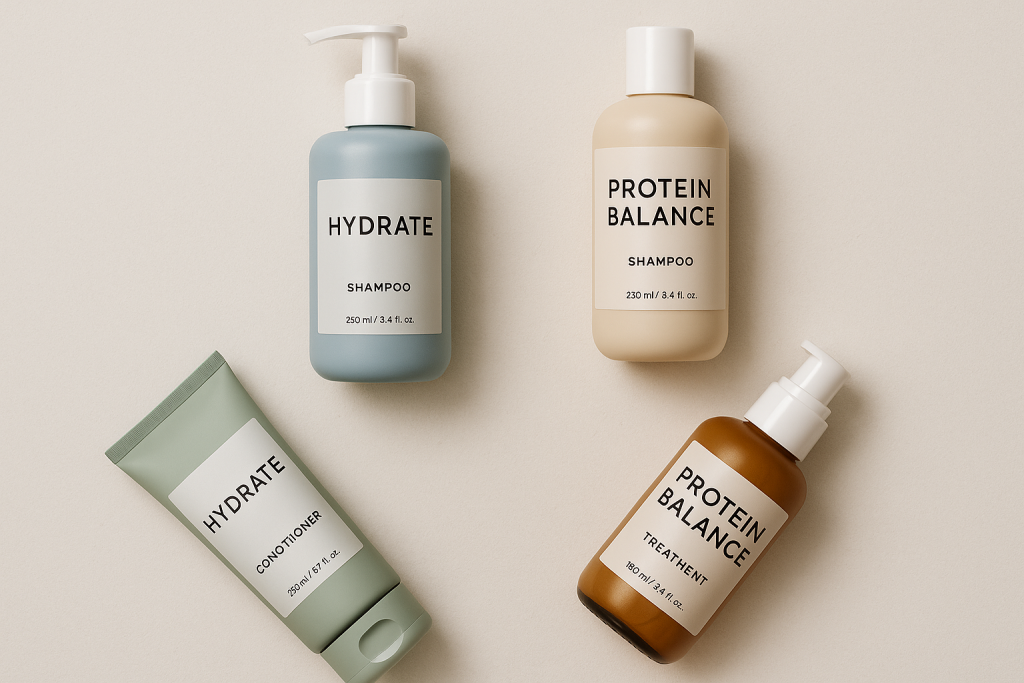
1. What Does “Over-Conditioning” Really Mean?
Let’s be honest — we all love the feeling of silky-soft hair fresh out of the shower. But sometimes that softness comes at a cost.
Over-conditioning happens when your hair absorbs too much moisture and not enough protein or structure to balance it. The result? Strands become too pliable, overly coated, and lose their natural bounce or volume.
💬 Think of it like soaking a sponge — it feels soft, but it can’t hold its shape anymore.
This imbalance affects every texture differently. For curly and coily hair, it can cause limp, undefined curls. For wavy and straight hair, it often leads to flat, greasy roots and stringy ends.
📎 External DoFollow Link: Healthline – Hair Moisture Overload Explained
2. 5 Warning Signs You’re Over-Conditioning
1. Your Hair Feels Too Soft… Almost Mushy
If your hair feels slippery or gummy when wet — that’s a red flag. Over-conditioning coats the strand so heavily that it loses grip and elasticity.
Curly Hair: Curls won’t spring back; they feel overly smooth and limp.
Straight Hair: Appears flat and greasy right after washing.
2. No Volume or “Root Lift”
When conditioners pile up on your scalp, they weigh down the roots — especially on straight or wavy textures.
Fix: Try a clarifying shampoo like Neutrogena Anti-Residue Shampoo once every 10–14 days to reset your scalp.
3. Frizz That Doesn’t Go Away
Yes, over-conditioned hair can still frizz — because the outer layer (cuticle) becomes overloaded and won’t close properly.
Pro Tip: Switch to lighter conditioners like SheaMoisture Lightweight Hydrate & Repair for curls or Pantene Daily Moisture Renewal for straight strands.
4. Styling Products Stop Working
When your hair is coated in too much conditioner, it creates a “film” that blocks other products (like curl creams, leave-ins, or heat protectants) from penetrating.
Curly Hair: Curl definition disappears.
Straight Hair: Hair resists holding a curl or style.
5. Tangled or Sticky Ends
Ironically, too much slip can lead to knots — your strands cling to one another instead of gliding.
Quick Fix: Add a weekly protein treatment like Olaplex No.3 or K18 Leave-In Repair Mask to rebuild structure.
📎 Internal Link: Read: Deep Conditioning — Why Curly Hair Needs It More Often
3. Why It Looks Different by Hair Texture
| Hair Type | What Over-Conditioning Looks Like | Why It Happens | How to Fix It |
|---|---|---|---|
| Curly (3A–3C) | Flat, undefined curls, no volume | Too much creamy conditioner + no protein | Clarify & use protein mask weekly |
| Coily (4A–4C) | Heavy, sticky curls lacking bounce | Thick leave-ins + oils layered too often | Alternate moisture/protein masks |
| Wavy (2A–2C) | Limp waves that won’t hold shape | Excessive hydrating products | Use lightweight rinse-outs only |
| Straight (1A–1C) | Greasy roots, stiff ends | Heavy silicones and buildup | Use clarifying shampoo + scalp exfoliator |
💬 Remember: Curls crave moisture, but structure comes from protein. Straight hair craves lightness, but shine fades with buildup.
📎 External DoFollow Link: Byrdie – How to Fix Over-Conditioned Hair
4. How to Fix Over-Conditioned Hair

The good news? You can reverse over-conditioning in just a few washes.
Step 1: Clarify Gently
Start with a clarifying shampoo like Ouai Detox Shampoo or Neutrogena Anti-Residue.
Use once weekly to strip excess product buildup.
Step 2: Reintroduce Protein
Apply a protein-rich mask (e.g., Olaplex No.3, K18, or Briogeo Don’t Despair, Repair!).
This strengthens your hair shaft and restores elasticity.
Step 3: Reduce Conditioner Frequency
If you condition daily — cut it down.
- Curly & Coily: 2–3x per week
- Wavy & Straight: 1–2x per week
Step 4: Use Lightweight Formulas
Switch to water-based or silicone-free conditioners for a few weeks.
Step 5: Balance With a Moisture–Protein Routine
Follow the “one-to-one rule”:
💧 For every deep moisturizing session → do one protein treatment the next week.
📎 Internal Link: Read: Moisture Balance 101 — How to Keep Curly Hair Hydrated and Straight Hair Light
5. Preventing It in the Future
To avoid over-conditioning long-term, keep your routine simple and balanced.
For Curly & Coily Hair
- Deep condition only once a week.
- Alternate between hydrating and strengthening masks.
- Use a leave-in spray, not a thick cream, on non-wash days.
For Wavy & Straight Hair
- Condition only the mid-lengths and ends.
- Rinse with cool water to prevent residue.
- Use clarifying shampoo every 10–15 days.
📎 External DoFollow Link: Expert Tips to Avoid Product Buildup
6. Recommended Products for Balance
| Type | Curly/Coily Hair | Wavy/Straight Hair |
|---|---|---|
| Clarifying | Ouai Detox Shampoo | Neutrogena Anti-Residue |
| Protein Treatment | Olaplex No.3, K18 Leave-In | Redken Extreme Builder |
| Light Conditioner | SheaMoisture Lightweight Hydrate | L’Oréal EverPure Moisture |
| Leave-In | Mielle Organics Pomegranate & Honey | Ouai Leave-In Mist |
💡 Pro Tip: Rotate your products — no single conditioner should dominate your shelf for more than 8 weeks straight.
7. Climate Tips: GCC Heat vs Global Weather
In GCC (UAE, KSA, Qatar, Oman):
- High humidity + hard water = faster product buildup.
- Use a filtered shower head to reduce mineral residue.
- Avoid leave-ins on scalp days; focus on mid-lengths down.
In Cooler Climates:
- Indoor heating dries hair out → moisture masks weekly.
- Protein masks every 2 weeks to maintain strength.
- Switch to a silk pillowcase — reduces friction + frizz.
📎 Internal Link: Read: The Right Water Temperature for Curly vs Straight Hair
8. Final Thoughts
So, what are the real signs you’re over-conditioning (and how it differs by texture)?
It’s all about recognizing the imbalance.
✨ Curly & Coily Hair: Be careful not to drown your curls in moisture — alternate with protein.
🌤️ Wavy & Straight Hair: Focus on light hydration and volume-friendly care.
Your conditioner should never weigh you down — it should lift your hair’s natural beauty instead.
💬 Remember: It’s not about using less care, but the right kind of care.
📎 External DoFollow Link: American Academy of Dermatology – Hair Conditioning Tips


Leave a Reply